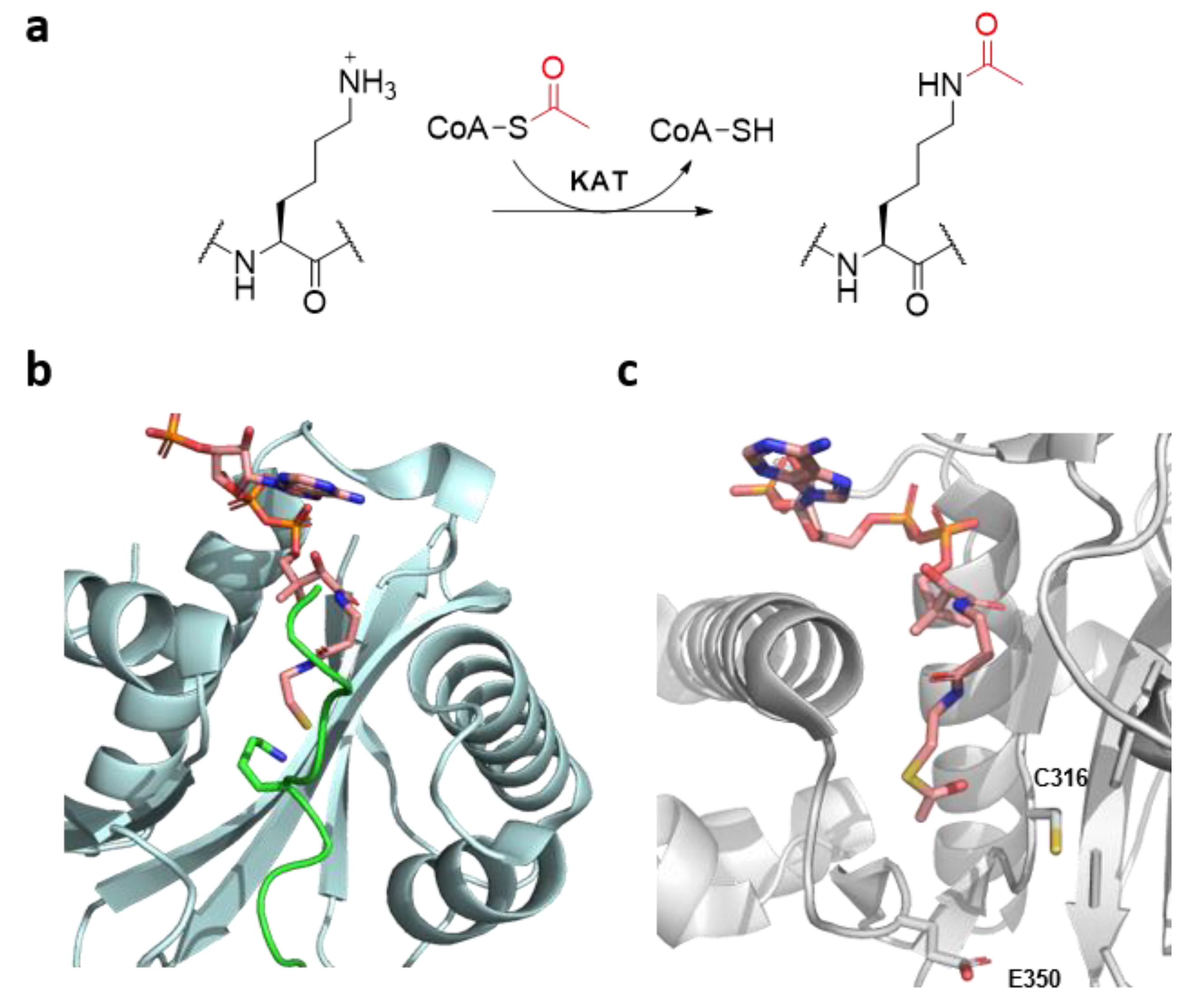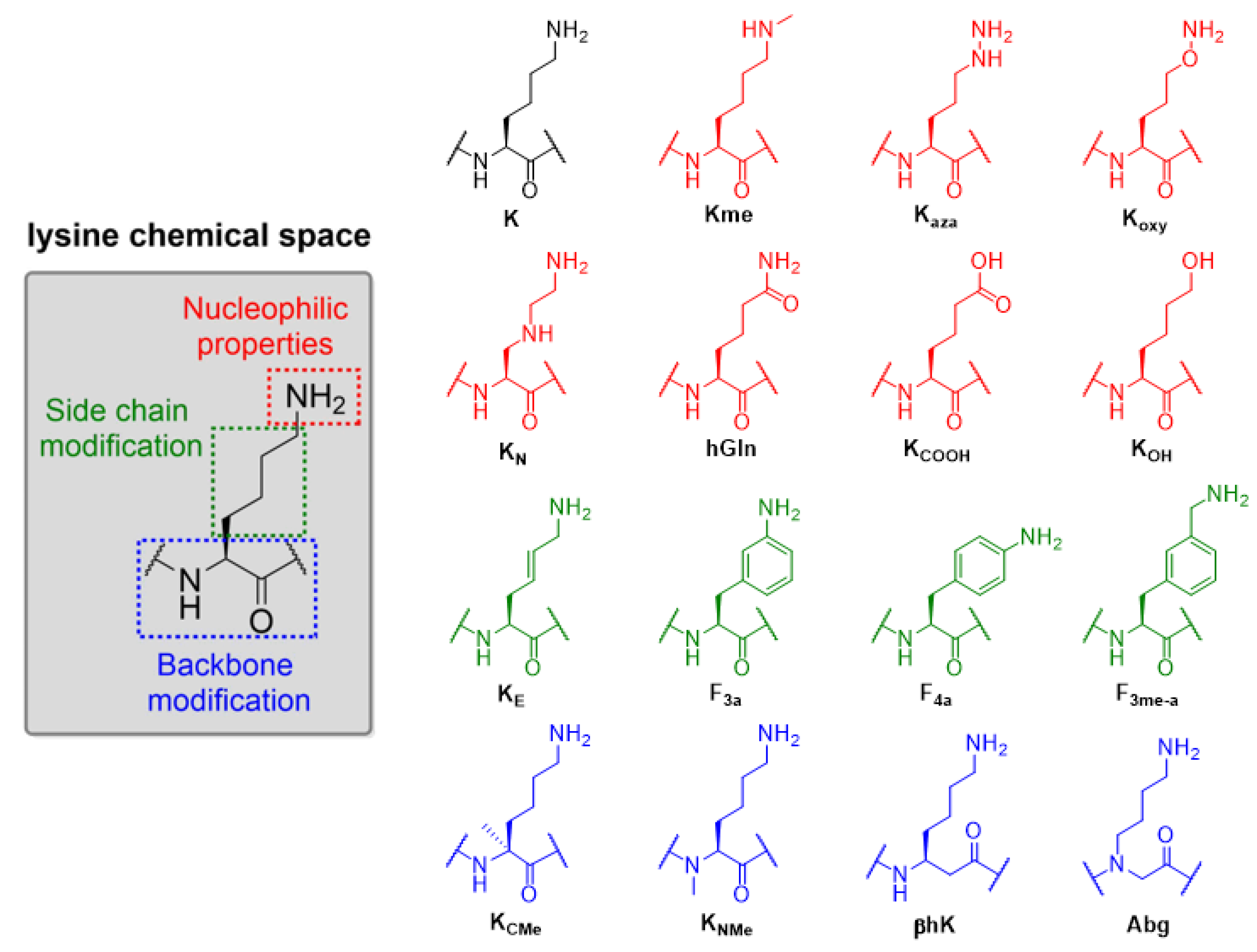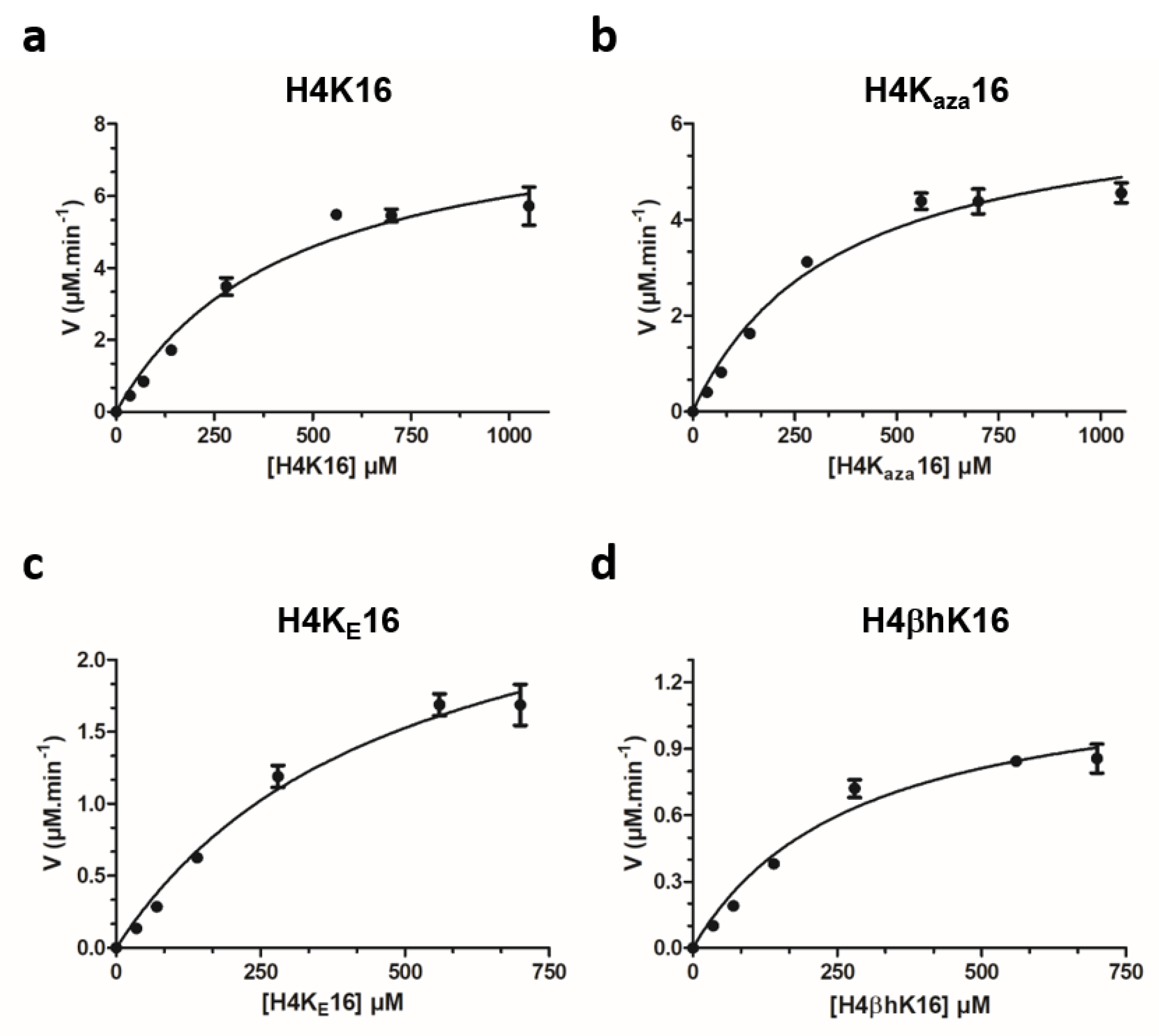Substrate Scope for Human Histone Lysine Acetyltransferase KAT8
Abstract
1. Introduction
2. Results and Discussion
2.1. Selection and Synthesis of KAT8 Peptide Substrates
2.2. KAT8 Enzymatic Assays
2.3. Kinetics Analysis
2.4. Anaysis of Peptides Inhibitory Profile
3. Materials and Methods
3.1. Synthesis and Purification of Histone Peptides
3.2. Expression and Purification of KAT8
3.3. MALDI-TOF MS Enzymatic Assays
3.4. MALDI-TOF MS Kinetics Assays
3.5. Inhibition Assays
4. Conclusions
Supplementary Materials
Author Contributions
Funding
Institutional Review Board Statement
Informed Consent Statement
Data Availability Statement
Acknowledgments
Conflicts of Interest
References
- Strahl, B.D.; Allis, C.D. The language of covalent histone modifications. Nature 2000, 403, 41–45. [Google Scholar] [CrossRef] [PubMed]
- Bannister, A.J.; Kouzarides, T. Regulation of chromatin by histone modifications. Cell Res. 2011, 21, 381–395. [Google Scholar] [CrossRef] [PubMed]
- Choudhary, C.; Weinert, B.T.; Nishida, Y.; Verdin, E.; Mann, M. The growing landscape of lysine acetylation links metabolism and cell signalling. Nat. Rev. Mol. Cell Biol. 2014, 15, 536–550. [Google Scholar] [CrossRef] [PubMed]
- Marmorstein, R.; Zhou, M.M. Writers and readers of histone acetylation: Structure, mechanism, and inhibition. Cold Spring Harb. Perspect. Biol. 2014, 6. [Google Scholar] [CrossRef] [PubMed]
- Seto, E.; Yoshida, M. Erasers of histone acetylation: The histone deacetylase enzymes. Cold Spring Harb. Perspect. Biol. 2014, 6. [Google Scholar] [CrossRef]
- Josling, G.A.; Selvarajah, S.A.; Petter, M.; Duffy, M.F. The role of bromodomain proteins in regulating gene expression. Genes 2012, 3, 320–343. [Google Scholar] [CrossRef]
- Bannister, A.J.; Miska, E.A. Regulation of gene expression by transcription factor acetylation. Cell. Mol. Life Sci. 2000, 57, 1184–1192. [Google Scholar] [CrossRef]
- Fiorentino, F.; Mai, A.; Rotili, D. Lysine acetyltransferase inhibitors: Structure-activity relationships and potential therapeutic implications. Future Med. Chem. 2018, 10, 1067–1091. [Google Scholar] [CrossRef]
- Barnes, C.E.; English, D.M.; Cowley, S.M. Acetylation and Co: An expanding repertoire of histone acylations regulates chromatin and transcription. Essays Biochem. 2019, 63, 97–107. [Google Scholar] [CrossRef]
- Proietti, G.; Wang, Y.; Rainone, G.; Mecinović, J. Effect of lysine side chain length on histone lysine acetyltransferase catalysis. Sci. Rep. 2020, 10, 13046. [Google Scholar] [CrossRef]
- Proietti, G.; Rainone, G.; Hintzen, J.C.J.; Mecinović, J. Exploring the Histone Acylome through Incorporation of γ-Thialysine on Histone Tails. Bioconjug. Chem. 2020, 31, 844–851. [Google Scholar] [CrossRef] [PubMed]
- Pfister, S.X.; Ashworth, A. Marked for death: Targeting epigenetic changes in cancer. Nat. Rev. Drug Discov. 2017, 16, 241–263. [Google Scholar] [CrossRef] [PubMed]
- Simon, R.P.; Robaa, D.; Alhalabi, Z.; Sippl, W.; Jung, M. KATching-Up on Small Molecule Modulators of Lysine Acetyltransferases. J. Med. Chem. 2016, 59, 1249–1270. [Google Scholar] [CrossRef] [PubMed]
- Wapenaar, H.; Dekker, F.J. Histone acetyltransferases: Challenges in targeting bi-substrate enzymes. Clin. Epigenetics 2016, 8. [Google Scholar] [CrossRef]
- He, M.; Han, Z.; Liu, L.; Zheng, Y.G. Chemical Biology Approaches for Investigating the Functions of Lysine Acetyltransferases. Angew. Chem. Int. Ed. 2018, 57, 1162–1184. [Google Scholar] [CrossRef]
- Thompson, P.R.; Kurooka, H.; Nakatani, Y.; Cole, P.A. Transcriptional coactivator protein p300. Kinetic characterization of its histone acetyltransferase activity. J. Biol. Chem. 2001, 276, 33721–33729. [Google Scholar] [CrossRef]
- Taylor, G.C.A.; Eskeland, R.; Hekimoglu-Balkan, B.; Pradeepa, M.M.; Bickmore, W.A. H4K16 acetylation marks active genes and enhancers of embryonic stem cells, but does not alter chromatin compaction. Genome Res. 2013, 23, 2053–2065. [Google Scholar] [CrossRef]
- Hsiao, K.-Y.; Mizzen, C.A. Histone H4 deacetylation facilitates 53BP1 DNA damage signaling and double-strand break repair. J. Mol. Cell Biol. 2013, 5, 157–165. [Google Scholar] [CrossRef]
- Schapira, M. Structural chemistry of human SET domain protein methyltransferases. Curr. Chem. Genom. 2011, 5, 85–94. [Google Scholar] [CrossRef]
- Al Temimi, A.H.K.; Amatdjais-Groenen, H.I.V.; Reddy, Y.V.; Blaauw, R.H.; Guo, H.; Qian, P.; Mecinović, J. The nucleophilic amino group of lysine is central for histone lysine methyltransferase catalysis. Commun. Chem. 2019, 2, 112. [Google Scholar] [CrossRef]
- Al Temimi, A.H.K.; Merx, J.; van Noortwijk, C.J.; Proietti, G.; Buijs, R.; White, P.B.; Rutjes, F.P.J.T.; Boltje, T.J.; Mecinović, J. Fine-tuning of lysine side chain modulates the activity of histone lysine methyltransferases. Sci. Rep. 2020, 10, 1–12. [Google Scholar] [CrossRef] [PubMed]
- Jogl, G.; Tong, L. Crystal structure of carnitine acetyltransferase and implications for the catalytic mechanism and fatty acid transport. Cell 2003, 112, 113–122. [Google Scholar] [CrossRef]
- Lecchi, P.; Olson, M.; Brancia, F.L. The role of esterification on detection of protonated and deprotonated peptide ions in matrix assisted laser desorption/ionization (MALDI) mass spectrometry (MS). J. Am. Soc. Mass Spectrom. 2005, 16, 1269–1274. [Google Scholar] [CrossRef] [PubMed]
- Temimi, A.H.K.A.; Tran, V.; Teeuwen, R.S.; Altunc, A.J.; Amatdjais-Groenen, H.I.V.; White, P.B.; Lenstra, D.C.; Proietti, G.; Wang, Y.; Wegert, A.; et al. Examining sterically demanding lysine analogs for histone lysine methyltransferase catalysis. Sci. Rep. 2020, 10. [Google Scholar] [CrossRef]
- Rojas, J.R.; Trievel, R.C.; Zhou, J.; Mo, Y.; Li, X.; Berger, S.L.; Allis, C.D.; Marmorstein, R. Structure of Tetrahymena GCN5 bound to coenzyme A and a histone H3 peptide. Nature 1999, 401, 93–98. [Google Scholar] [CrossRef]
- Wu, H.; Moshkina, N.; Min, J.; Zeng, H.; Joshua, J.; Zhou, M.M.; Plotnikov, A.N. Structural basis for substrate specificity and catalysis of human histone acetyltransferase 1. Proc. Natl. Acad. Sci. USA 2012, 109, 8925–8930. [Google Scholar] [CrossRef]
- Al Temimi, A.H.K.; Teeuwen, R.S.; Tran, V.; Altunc, A.J.; Lenstra, D.C.; Ren, W.; Qian, P.; Guo, H.; Mecinović, J. Importance of the main chain of lysine for histone lysine methyltransferase catalysis. Org. Biomol. Chem. 2019, 17, 5693–5697. [Google Scholar] [CrossRef]
- Al Temimi, A.H.K.; White, P.B.; Mulders, M.J.M.; van der Linden, N.G.A.; Blaauw, R.H.; Wegert, A.; Rutjes, F.P.J.T.; Mecinović, J. Methylation of geometrically constrained lysine analogues by histone lysine methyltransferases. Chem. Commun. 2020, 56, 3039–3042. [Google Scholar] [CrossRef]
- Wapenaar, H.; Van Der Wouden, P.E.; Groves, M.R.; Rotili, D.; Mai, A.; Dekker, F.J. Enzyme kinetics and inhibition of histone acetyltransferase KAT8. Eur. J. Med. Chem. 2015, 105, 289–296. [Google Scholar] [CrossRef]




| H4 Peptide | kcatapp (min−1) | KMapp (μM) | kcatapp/KMapp (mM−1 min−1) |
|---|---|---|---|
| H4K16 | 15 ± 0.8 | 437 ± 107 | 34 |
| H4Kaza16 | 12.4 ± 0.5 | 405 ± 66 | 31 |
| H4KE16 | 5.3 ± 0.4 | 486 ± 124 | 11 |
| H4βhK16 | 2.2 ± 0.1 | 283 ± 67 | 8 |
Publisher’s Note: MDPI stays neutral with regard to jurisdictional claims in published maps and institutional affiliations. |
© 2021 by the authors. Licensee MDPI, Basel, Switzerland. This article is an open access article distributed under the terms and conditions of the Creative Commons Attribution (CC BY) license (http://creativecommons.org/licenses/by/4.0/).
Share and Cite
Proietti, G.; Wang, Y.; Punzo, C.; Mecinović, J. Substrate Scope for Human Histone Lysine Acetyltransferase KAT8. Int. J. Mol. Sci. 2021, 22, 846. https://doi.org/10.3390/ijms22020846
Proietti G, Wang Y, Punzo C, Mecinović J. Substrate Scope for Human Histone Lysine Acetyltransferase KAT8. International Journal of Molecular Sciences. 2021; 22(2):846. https://doi.org/10.3390/ijms22020846
Chicago/Turabian StyleProietti, Giordano, Yali Wang, Chiara Punzo, and Jasmin Mecinović. 2021. "Substrate Scope for Human Histone Lysine Acetyltransferase KAT8" International Journal of Molecular Sciences 22, no. 2: 846. https://doi.org/10.3390/ijms22020846
APA StyleProietti, G., Wang, Y., Punzo, C., & Mecinović, J. (2021). Substrate Scope for Human Histone Lysine Acetyltransferase KAT8. International Journal of Molecular Sciences, 22(2), 846. https://doi.org/10.3390/ijms22020846






